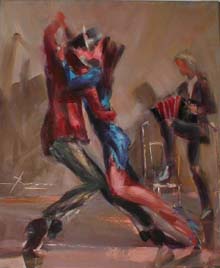
Introduction

The varied look of Argentina





![]()
Argentina |
We wake up in the morning to the birds now chirping outside the patio doors of our bedroom. Coffee is brewing because my sister Kathy has slightly preceded our arising. Soon she steps out her door, down the block to one of the nearby bakeries where she will select a variety of morning pastries. That was the morning ritual during our two-week stay at Kathy’s house in Buenos Aires Argentina. For the rest of our time it didn’t matter what we did – we just knew it would be fun. I had the pleasure, on our first day in Buenos Aires, of being the only male attendee at Kathy’s monthly University Women’s Club luncheon, this month held at the South African Embassy. Soon Ramona and I learned that meal times do not, in Argentina, equate to those in Minnesota. Breakfast is a non-meal of coffee or tea and breads; lunch occurs in the afternoon - well after I’ve finally gotten over being hungry; and suppertime? - it begins after bedtime. Our first evening at Kathy’s we met her sons Augustine and Eugenio - for the first time as adults. The guys prepared a BBQ of a variety of sausages; with salad, wine and breads to accompany the meal. Exhausted from our long journey, Ramona and I retired – late for us – early for the Argentine. The following day would offer an introduction to the music Argentines are best known for – the Tango. Within what once was an elaborate mansion but is now an elegant hotel, is a large room where Tango is taught by a few young dancers who we would later have the privilege of watching during a performance. But first – we learn the Tango – at least to the extent that 45 minutes of intense training can provide. And later we move to a small auditorium where we may observe our instructors perform the Tango in the way it was intended to be danced. On stage were three musicians – one playing a piano, another a concertina and the third a guitar. We were introduced to the style changes of the Tango from the 1920’s to the present. Having earlier that day - endured a tiring journey by subway from Kathy’s home to our musical unveiling, we were pleased that Kathy’s friend Maria was able to drive us part way home so that a short cab ride would be affordable. Music still ringing in my head & legs tested by movements not experienced in recent years, I slept well that night. Unlike Europe, which is expensive, Buenos Aires provided us with world-renown nightlife, cuisine, and shopping for much less a price. Another great thing about Buenos Aires is its people, which are attractive, sophisticated, and welcomed us with open arms Buenos Aires is a smart, contemporary city that is full of life and bursting with energy. While the spirit of the tango is alive and well and the gaucho heritage is celebrated, modern Argentina is more cosmopolitan in its outlook than many other countries we had visited. Buenos Aires' physical structure is a mosaic as varied and diverse as its culture. The city has no dominating monument, no natural monolith that serves as its focal point. Instead, Buenos Aires is composed of many small places, intimate details, and tiny events and interactions, each with a slightly different shade, shape, and character. Glass-sheathed skyscrapers cast their slender shadows on 19th century Victorian houses and little restaurant/bars hazed with the piquant tang of cigar smoke across the way. The neighborhoods are small and highly individualized, each different from the other. While strolling the avenues, Ramona, Kathy and I would pass from what appeared as Spanish Colonial design to Italian detailing and later graceful French Classicism. While on the train we might see tin houses painted a rainbow of colors, with muralists that have turned that district's side-streets into avenues of color. |